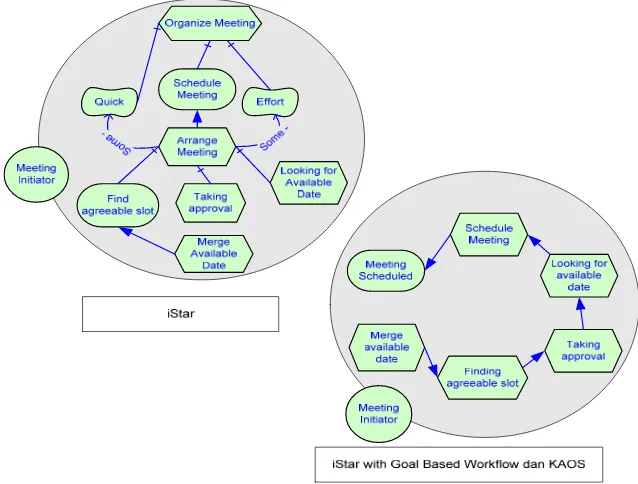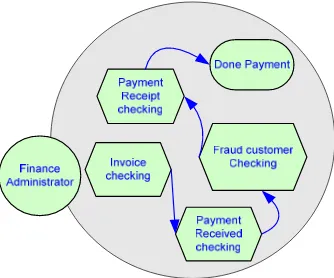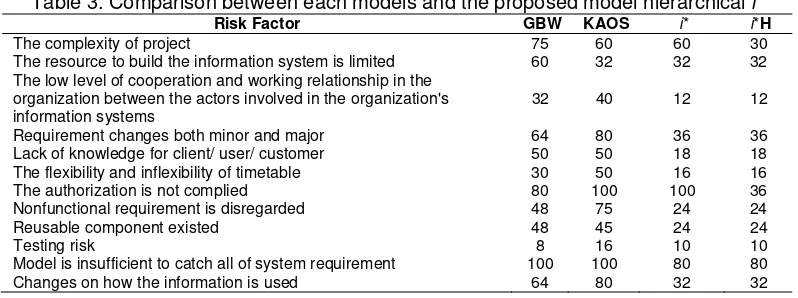DOI: 10.12928/TELKOMNIKA.v14i1.3333 784
Hierarchical
i
* Modeling in Requirement Engineering
Kridanto Surendro*, Cicely Martini
School of Electrical Engineering & Informatics, Bandung Institute of Technology, Jl. Ganesa 10 Bandung, Indonesia
*Corresponding author, e-mail: [email protected]
Abstract
Requirement engineering is first phase of information system development process. This phase aims to fully observe and define the needs of system and users. In this phase, the defined needs will be formulated into a form that can simplify the analysis process. Requirement engineering approach with intentional perspective is one of argument which is coming to surface in requirement engineering topics. In intentional modeling, the focus will be pointed on the motive of actors, how they fulfill every need, and what are dependencies along their success stories. Some existing intentional modellings still stand under limitations. For example, this modelling approach has complexity problem when it is used to real big cases. Moreover, the limitation is pointed on how to describe hierarchical conditions into the intentional model. This research is focused on the improvement of existing intentional modelling to handle the limitations in describing the hierarchical conditions.
Keywords: Requirement Engineering, Goal based workflow, i* hierarchy, intentional modeling
Copyright © 2016 Universitas Ahmad Dahlan. All rights reserved.
1. Introduction
Requirement engineering approach through intentional perspective is one of the arguments that appear in requirement engineering topics. The argument says that when we need to define system requirement, we also need to examine and understand the relationship among social actors in domain [1]. The focus in Requirement Engineering is no longer focused on understanding of systems’ behavior, but it is more about how the system helps social actors to improve relationship among them in their organization. Intentional modeling focus on the desire of every actor, how each actor can achieve their desires and dependencies anything contained in the effort to achieve its aspirations.
The relationship among social actors in the domain causes intentionality that can be described by using the Goal Oriented Requirement Engineering (GORE) approach [2]. GORE introduces the understanding that organization and the actors as the source of requirement. GORE approach models goal because the goal is the reason of why do some actors have an intentionality, which will directly became the candidate of the system requirements. Generally, GORE approach involves the understanding of why is a system function is required, and how the system functions can be implemented.
There are some intentional modeling that use GORE approach. Those are objective modeling, Goal Based Workflow, KAOS model and i* [3, 4]. The requirement engineering issues are about complexity, ease of performing hierarchy representation, and easiness of performing representation activities concurently. Those models are failed when they are related to hierarchy and organization which adopts delegation concept. It drives the need of a simple hierarchy representation which represents cooperation within organization. In order to handle this hierarchical problem, a proposed intentional modeling is developed. It puts hierarchy representation and delegation inside the intentional modeling.
2. Research Model
first step of a system reliability study. It involves reviewing as many components, assemblies, and subsystems as possible to [5].
Figure 1. Mind Map of Research i* Hierarchy [6]
3. Proposed Model
Requirements are often defined unclearly. For example: "I need a system that can improve the efficiency of my department". Finally the expression of requirement has to be broken down in detail. This activity result will be used as the base to build the system. Thus, we begin to recognize the expression levels of the requirement. It starts from finding the requirement expression of stakeholders. After that, we have to discover potential and suitable solution. By using the multiple layers of requirements expression, we need to trace requirements in order to trace down the relationship between the requirements of each layer [7].
There are several variations of i* framework [8]. Unfortunately, there is still an incomplete element from definition of inheritance concept. There are several studies which use inheritance, but those studies are not clearly mentioning this concept or providing guidelines for its use [9].
In the Multi-Stakeholder Distributed System (MSDS) [10] in which each element is created, owned, and implemented by individual stakeholders, there are limitations of i* such as in defining needs of diverse stakeholders. The problem rises when MSDS model needs to use the inheritance in order to create hierarchy of actors [11]. In an organization, the actor inherits the same organizational goal and they must not have their own goal. Therefore, there will be guarantee for healthy teamwork without competition among actors [12]. By having a well-defined goal, the actors have responsibility to help organization to reach the goal. By monitoring the responsibility level of every actor, the needs can be seen. However, the responsibility can be delegated by organizational actors from higher layer to other organizational actors in the lower hierarchy [13]. Once the organizational structure is formed, the goal can be mapped according to the hierarchy of actors who have these goals [14].
3.1. Hierarchical i* Modeling
The base to support the business with information technology (IT) usually starts from an understanding of the stakeholders’ requirements. IT systems are often unable to respond the business’ needs because the lack understanding. The understanding on requirements are just viewed from some stakeholder’s perpective. The use of the term "user" usually directs the person who records requirements perceive that the needs of all stakeholders have been recorded. In contrary, there are still stakeholder’s requirement left and unrecorded [15].
One characteristic that should be seen is the level of organization, the operational level to the non-operational level [15]. Requirements of some models only capture the needs of one layer. This model focus on operational layer which means the actor is a system operator. As a result, the needs of stakeholders in the non-operational layer such as head of division or directors are often not recorded. For an example, as we can see in a use-case model which is closer to the operational side, rather than the non-operational.
result in the logical structure of classifying and organizing the descriptive representations from the intentional and social condition of organizations. In a hierarchical structure of actors, it is necessary to describe some layers of hierarchy as follows:
1) Layers of Directors 2) Layer of Managers 3) Layer of Administrators
Layer of Directors is a layer where there are actors who have business goals and business plan to run the company, as well as the strategies that they will do to achieve these goals. Actors in this layer are not necessary to be connected to the system directly, but they have interests which meet the implementation of business processes in the managers and administrators layer, includes the business processes that involve system. These actors will get higher benefit than the functional benefits.
Layer of Managers is a layer where there are actors who have rules of business processes as a concrete manifestation of the efforts to achieve the business goals that are owned by the actor in the layer of directors. The actors in this layer are also the ones who benefit from the passage of a functional system. In carrying out its role, manager own Business Rule Model which will involve actors from the layer below them which means the manager will engage the administrators. Actors in the layer manager could have been directly related to the system, but their portion is not as much as the actors in the layer of the administrator.
Layer of Administrator is a layer in which the actors operate system to execute command, process, and monitor the output of a process. In this layer, business rules become more specific and the division of roles occurred among existing actors. Actors in this layer invest the largest amount of time to interact with system.
Delegation is a common task in the organization. It happens because of the presence of certain position in the organization. Every employee in an organization has a certain position in order to accomplish some business functions. Different positions within an organizational hierarchy have different autonomy, decision maker, and responsibilities [16].
By using the form which is contained in the hierarchy of an organization, then the dependence on the top level (e.g. dependencies among directors) may be delegated to subordinates in the form of task or goal. In Figure 2, Actor1 delegates the tasks to actor2 who acts as subordinate. Moreover, as we can see in figure 2, the D symbol refers to delegation.
Figure 2. Delegation Relationship between Actors in Strategic Dependency
To simplify the modeling, the Actor 1 is perceived as delegation to actor2. Although in daily life, the directors have some managers underneath them.
When the delegation of goal and task are occured at lower levels of the hierarchy, we can create subgoal or subtask. These subgoal and subtask are assigned as goal and task for lower level of hierarchy.
In modeling i*, internal processes among the actors are established in the form of goal, task, resource, and soft goal. This internal process is described in the Strategic Rationale. There is a sequential process in the Strategic Rationale. It is presented as means-ends link, but it is unable to describe the sequences of process which are performed by actor. By using and applying the principle of activity in Goal Based Workflow on the task, each task decomposition can be transformed in order to clarify the sequential order in i*. Figure 3 is an example of actor whom we name as a Meeting Initiator. As we can see at Figure 3, the left side represents the modeling which is using i*, meanwhile the right part uses the principle of Goal-based workflows and KAOS. In goal-based workflow approach the activity of making the task is an activity to achieve certain goals, while KAOS defines tasks as necessity. By using both approaches, the required tasks to reach the goals will be well-structured.
Figure 3. Comparison between Strategic Rationale between i* and i* with Goal Based Workflow and KAOS approach
4. Case Study
In this research, we use the process of selling items in as a case study. Sales process involves Sales, Inventory, and Finance. Sales department receives demands of items from customers. In carrying out the process, the sales department should collaborate with Inventory and Finance.
A customer who orders the items will request the sales order to Sales department. Sales department will create sales order items which are requested by customer. Afterwards, customer’s order will be executed and delivered by the inventory clerk. Then the order will be forwarded to the finance department in order to issue the payment inquiry.
4.1. Strategic Dependency
goal “sales order” and task “sales order input creation” to the Sales Manager. Sales Manager delegates goal “sales order creation” and task “lists inventory sales” to sales administrator.
The Inventory Director delegates goal “inventory creation” and task “shipping of items to the buyer” to the Inventory Manager. Inventory managers delegate goal “to put the sales package to expedition” to the Inventory administrator.
By looking at Sales and Inventory and connectedness between involved actors, we can clearly see each function which is must be existed for each level based on the hierarchy in order to do requirement engineering. The chart hierarchical i* can be seen as Figure 4.
Figure 4. Strategic Dependency between Sales and Inventory
4.2. Strategic Rationale
In the case of item sales, Figure 5 illustrates the Strategic Rationale for Financial Administrator. Internal process of financial administrator is started with checking the payment proof. It is also followed by checking incoming payments. After that, the financial administrator checks the possibility of customer fraud, and final activity is creating the payment receipt letter. By looking at the form of the strategic rationale as we can see in Goal-Based Workflow, we can clearly see the continuity of the internal processes of every actor.
5. Model Assessment
The assessment of proposed model will engage the risk assessment for the process of selling item. Failure Mode and Effects Analysis (FMEA) provides an organized and critical analysis to assess risk factors which are occurred in the process or defined methods. For each risk factor, we have to specify three values. Those are severity (how bad is the result of the risk factor/ Sev), occurrence (how often the risk factors occurred/Occ), and detection (how detectable is the risk factor/Det). Those three values are multiplied to produce a Risk Priority Number (RPN). If the RPN is lower than a certain limit, the risk is acceptable which means we do not need to have extra precaution. Table 1 shows the Risk Level for the assessment and Table 2 shows the RPN score for Hierarchy i*.
Table 1. Risk Level [6]
Risk Priority Number (RPN) Risk Level
1-25 Very Low
26-50 Low 51-75 Moderate 76-100 High
101-125 Very High
Table 2. RPN score for proposed model Hierarchical i*
No Risk Factor Sev Occ Det RPN Risk Level
1 The complexity of project 5 3 2 30 Low
2 The resource to build the information system is limited 4 2 4 32 Low 3 The low level of cooperation and working relationship in
the organization between the actors involved in the organization's information systems
To find the comparison with other models, the proposed model of hierarchical is tested by comparing it to the Goal-Based Workflow (GBW), KAOS, i*, and i* Hierarchical (i*H) model for the same case. When RPN value of each model compared to one another, it will be found that the value of RPN to proposed model of hierarchical i* is lower than other models, as we can see Table 3.
Table 3. Comparison between each models and the proposed model hierarchical i*
Risk Factor GBW KAOS i* i*H
The complexity of project 75 60 60 30
The resource to build the information system is limited 60 32 32 32 The low level of cooperation and working relationship in the
organization between the actors involved in the organization's information systems
32 40 12 12
Requirement changes both minor and major 64 80 36 36 Lack of knowledge for client/ user/ customer 50 50 18 18 The flexibility and inflexibility of timetable 30 50 16 16
The authorization is not complied 80 100 100 36
Nonfunctional requirement is disregarded 48 75 24 24
Reusable component existed 48 45 24 24
Testing risk 8 16 10 10
6. Conclusion
The implementation of the hierarchy and delegation in i* modeling as Requirement Engineering will ease the development of Information Systems because it catches more detailed needs in every level, from Director to the Administrator. Due to higher level of complexity compared to other modeling, the hierarchy is used for modeling i* in certain cases, for example in companies that have a tiered approval mechanism, as well as upper level monitoring.
Goal-Based Workflow approach on Strategic Rationale in i* modeling enables the easier way to observe what is happening on each actor sequentially. This coupled with event implementation as in KAOS, so that work’s sequences to achieve the goal in the internal actors are clearly seen.
The limitation of hierarchical i* is pointed on the disability in describing the obstacles that may occur in the assignment from the upper level to the lower level. Development of the proposed model can be directed to accommodate different organizational forms and it may also engage the companies with various actors.
References
[1] Yu, Eric, Paolo Giorgini, Neil Maiden, John Mylopoulos. Social Modeling for Requirements Engineering: An Introduction. MIT Press. 2011.
[2] Lapouchnian A. Goal-Oriented Requirements Engineering: An Overview of the Current Research. Department of Computer Science University of Toronto; 2005
[3] D Ross, K Schoman. Structured Analysis for Requirements Definition. IEEE Transactions on
Software Engineering. 1977; 3(1): 6-15.
[4] Maria V, Werneck B, Padua AD, Oliveira A, Cesar J, Leite P, São R. Comparing GORE Frameworks:
iStar and KAOS. Ibero-American Workshop of Engineering of Requirements. Chile. 2009.
[5] Rausand M, Hoylan A. System Reliability Theory: Models, Statistical Methods, and Applications. Second Edition. Wiley Series in probability and statistics. 2004: 88.
[6] Martini M. I-star Hierarchy Modeling in Requirement Engineering. Theses. Bandung: Institute of Technology Bandung; 2012.
[7] Hull Elizabeth, Jackson Ken, Dick Jeremy. Requirements Engineering. Springer. 2011.
[8] Gemma Grau, Carlos Cares, Xavier Franch, Fredy J Navarrete. A Comparative Analysis of i* Agent-Oriented Modelling Techniques. In Proceedings of the Eighteenth International Conference on Software Engineering and Knowledge Engineering. San Francisco, USA. 2006
[9] López L. A Complete Definition of the Inheritance Construct in i*. Proceedings of the ER 2009 PhD
Colloquium, affiliated to the 28th International Conference on Conceptual Modeling. Brazil. 2009.
[10] Clotet R, et al. Requirements Modelling for Multi-Stakeholder Distributed Systems: Challenges and
Techniques. Proceedings of the First International Conference on Research Challenges in Information Science, RCIS 2007. Ouarzazate, Morocco. 2007.
[11] López L, Franch X, Marco J. Defining Inheritance in i * at the Level of SR Intentional. Proceedings of the 3rd International i* Workshop. Brazil. 2008.
[12] Yu, Eric S. Modelling Strategic Relationships for Process Reengineering. PhD thesis. Canada; 1996.
[13] Chopra AK, Giorgini P. Requirements Engineering for Social Applications. Proceedings of the 5th
International i* Workshop. Italy. 2011: 138-143.
[14] Rahwan I, Juan T, Sterling L. Integrating Social Modelling and Agent Interaction through
Goal-Oriented Analysis. International Journal of Computer Systems Science & Engineering. 2008; 21(2):
87-98.
[15] Alexander, Ian F. A Better Fit – Characterising the Stakeholders. CAiSE'04 Workshops in connection
with The 16th Conference on Advanced Information Systems Engineering. Riga, Latvia. 2004: 215-223.
[16] Kuan PP, Karunasekera S, Sterling L. Improving Goal and Role Oriented Analysis for Agent Based
![Figure 1. Mind Map of Research i* Hierarchy [6]](https://thumb-ap.123doks.com/thumbv2/123dok/245599.503546/2.595.146.451.134.246/figure-mind-map-research-i-hierarchy.webp)



